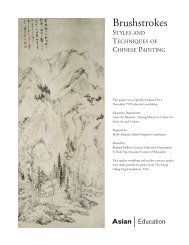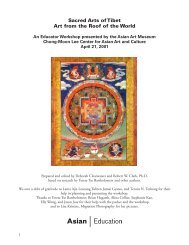Download PDF - Asian Art Museum | Education
Download PDF - Asian Art Museum | Education
Download PDF - Asian Art Museum | Education
You also want an ePaper? Increase the reach of your titles
YUMPU automatically turns print PDFs into web optimized ePapers that Google loves.
this—mono no aware, a pathos for the fleeting moments of beauty, joy, even heartbreak<br />
that are part of being human. These emotions and actions are portrayed using subtle means<br />
in the pictures. For example, once we know that the figures on the boat are lovers stealing<br />
away together, the inclining of their heads towards each other takes on new significance. On<br />
the other hand, the scene in the lower left represents a woman trying to deflect unwanted<br />
advances.<br />
The book was first illustrated in handscroll form, with sections of text interspersed with<br />
select images. It was painted in a consciously Japanese style called yamato-e. The text was<br />
written in Japanese—during Murasaki’s day, men generally studied and wrote poetry in Chinese,<br />
whereas women excelled in writing verse and prose using their native language and<br />
script called kana.<br />
How does this 17th century screen relate to the 12th century handscrolls?<br />
These screens were painted some 600 years after Murasaki wrote her novel, and some 400<br />
years after the earliest surviving paintings of the subject. There are hundreds of Genji images<br />
in collections all over the world, in a variety of formats and styles, from handscrolls to writing<br />
boxes, and from refined courtly paintings to irreverent spoofs in woodblock prints. The<br />
subject was particularly popular during the Edo period, as part of a revival of courtly aesthetics<br />
particularly among courtiers and merchants in Kyoto. With increased literacy of the<br />
Edo populace, and woodblock renditions of the story available relatively cheaply, more people<br />
could read the book and were familiar with the standard images.<br />
What scenes are depicted here?<br />
(Note: only the left screen is included in the slides. For information on the right screen, see<br />
Kakudo, pp. 120–121.)<br />
Viewer discretion advisory: The Tale of Genji is a romantic novel about the various affairs of<br />
the nobility; it contains some steamy love poetry and a good deal of innuendo. We provide<br />
uncensored information here, leaving it for teachers—you know your students best—to decide<br />
how to introduce the material.<br />
Imagine the left screen is divided into two sections, upper and lower. In the upper section,<br />
chapter 51 Ukifune (A Boat upon the Water) is portrayed. The lower section illustrates<br />
chapter 30 Fujibakama (Purple Trousers).<br />
Chapter 30 Fujibakama (Purple Trousers)<br />
The bottom half of this screen depicts one scene from Chapter 30, “Purple Trousers,” a<br />
playful name for a lavender flower that blooms in fall. Yugiri, the son of Genji, comes as a<br />
messenger to the home of Tamakazura, who is seated inside the building behind transparent<br />
curtains. One of her attendants is seated on the verandah. Due to a recent death in the<br />
court, all the characters are supposed to be in mourning, but that does not stop Yugiri from<br />
pursuing Tamakazura.<br />
Perhaps thinking that there would be another occasion to let her know of his interest, he<br />
had come provided with a fine bouquet of “purple trousers.”<br />
“We may find in these flowers a symbol of the bond between us.” He pushed them<br />
under her curtains and caught at her sleeve as she reached for them.<br />
<strong>Asian</strong> <strong>Art</strong> <strong>Museum</strong> <strong>Education</strong> Department
















